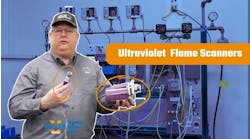THEY CALLED BECAUSE they wanted a second opinion and a price for the installation of a new gas valve on their furnace.
Their home was on the way to another call, so I agreed to stop by. As we descended into the basement, the base of the furnace began to appear and it was obvious this would be a dinosaur from the days when coal was king. A Gordon conversion burner, the Cadillac of conversion burners from a bygone era, sat forlornly with its lid askew. Lifting off the cover, I discovered that the motorized gas valve had died an ugly death.
Lifting the manual lever would allow for the burner to run (providing the pilot was still lit), and that is what the homeowners had been doing to stay warm. The combustion chamber was sooty and the flame spreader above the burner held a soot-cicle directly above the pilot.
Installing a new gas valve on a Gordon conversion burner requires removal of the motorized valve and its linkage to the air damper, which should have set off an alarm bell for the previous bidder. Under normal operation, the motorized valve opens the combustion air damper as the burner ignites and closes it when the burner loses its voltage signal, and the valve’s internal spring winds it to the off position.
Save a dinosaur? As a repair mechanic, I always find it rewarding to know I can bring just about any product back from the brink of death. But there comes a time when repairs no longer make sense and, as was the case here, liability issues become far too great.
A replacement gas valve would reside outside the Gordon burner box and the air damper would need to be adjusted and locked open to provide proper combustion, which would be dependent on the burner’s gross input. I had no doubt that this burner was already producing excessively high amounts of carbon monoxide and, judging by the undisturbed connection where flue met chimney, this 100-year-old-plus chimney had not been checked for blockage.
Aside from numerous safety issues, alterations to manufacturer’s products place you squarely in the crosshairs of liability.
We also have a professional responsibility to educate and guide consumers toward what’s best for them and the environment. Investing hundreds of dollars in an 85-year-old furnace that’s operating at 60% (or less) efficiency makes little, if any, sense. We have available to us any number of heating products (furnaces, boilers and water heaters) that operate at very high-efficiency rates — up to 99%. Fossil fuels are not renewable and will eventually be depleted.
“No one will pay the premium for high efficiency; condensing boilers cost too much; all my customers want everything done on the cheap; the payback is too long.” And so on.
It’s all too easy to travel the low road and fight with the bottom-feeders along with the big-box DIY outlets. If cheap, cheap, cheap is all you want in this business, then go get yourself a flock of chickens. Don’t get sucked into the low-ball mentality by thinking you can go head-to-head with the lowest pricing. That’s a dead-end road. Somebody’s selling those high-efficiency high-end products and you should be as well.
Step one: Take the high road. For starters, drop the price game right off the bat. You want to know who your competition is where sales are concerned? It’s you. You can be your own worst enemy on any given sales call if you don’t begin by selling yourself first. And that doesn’t mean you need to brag about your achievements. Instead, begin by securing the consumer’s confidence in your abilities and knowledge. In this case, by pointing out what was obvious to me, but not to the homeowner: the soot in the chamber; the soot-cicle and its cause; the chimney; the function of the air damper; CO; and that then leads into discussion of things such as the unlined chimney.
It’s very easy to educate and lead the conversation toward features you and your company can provide.
Step two: Promote your company. Take a moment to look at your company from an outsider’s point of view. Taking care of things you take for granted, and these can be simple things like cleaning up or removing the old clunker, can help plant the seed that you are their best option.
Step three: Be an active listener. If you’re like most contractors, you’ve developed loyalty to a number of products and you need to think about why you’re bringing that product to the table. If you were an active listener during the conversation with the clients, you’ll know how to present the product’s features in a way that will captivate their interest.
Last step: Up-sell the job. Give your customer options. In this case, the homeowners will receive a written proposal that’s menu-driven with a fair number of options: 82% AFUE furnace with a chimney liner vs. 94% condensing furnace; programmable thermostats; humidifiers; filtration; etc.
You’ll be pleasantly surprised to find that most will choose the high-end products. While price is still a consideration, it’s no longer the foundation for their decision.
Dave Yates owns F.W. Behler, a contracting company in York, Pa. He can be reached by phone at 717/843-4920 or by e-mail at [email protected].

